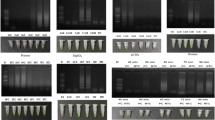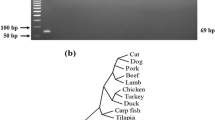Abstract
This report described a cytochrome b (cytb)-based polymerase chain reaction (PCR) assay for the detection of canine tissues in commercial frankfurters. Discriminating detection of canine derivatives in processed food products has important application in halal authentication as well as in health, religions, and fare trades. The assay based on a pair of canine-specific primers that targeted a 100 bp region of canine mithochondrial-cytb gene which is present in multiple copies and highly conserved within the same species. The specificity of the assay was tested against dog and eight most common animal meat species as well as five plant species commonly found in frankfurter formulation. The stability and specificity of the assay were verified under different thermal processing conditions under pure and complex matrices. Three commercial brands of chicken and beef frankfurters were tested in triplicate, and specific PCR products were obtained only from deliberately contaminated formulations. The detection limit of the assay was 0.1 % (0.02 ng DNA) of canine meat spiked with other meats in a typical frankfurter formulation. Shorter amplicon length, superior stability, and higher sensitivity of the assay suggested its potential application in the screening of canine-origin biomaterials in processed food products.




Similar content being viewed by others
References
Abdel-Rahman S, El-Saadani M, Ashry K, Haggag A (2009) Detection of adulteration and identification of cat’s, dog’s, donkey’s and horse’s meat using species-specific PCR and PCR-RFLP techniques. Aus J Basic Appl Sci 3:1716
Abdulmawjood A, Schönenbrücher H, Bülte M (2003) Development of a polymerase chain reaction system for the detection of dog and cat meat in meat mixtures and animal feed. J Food Sci 68:1757
Ali ME, Hashim U, Mustafa S, Man Y, Yusop M, Kashif M, Dhahi TS, Bari M, Hakim M, Latif M (2011) Nanobiosensor for detection and quantification of DNA sequences in degraded mixed meats. J Nanomater 2011:32
Ali ME, Hashim U, Mustafa S, Che Man YB (2012a) Swine-specific PCR-RFLP assay targeting mitochondrial cytochrome B gene for semiquantitative detection of pork in commercial meat products. Food Anal Method 5:613
Ali ME, Hashim U, Dhahi TS, Mustafa S, Man Y, Latif MA (2012b) Analysis of pork adulteration in commercial burgers targeting porcine-specific mitochondrial cytochrome B gene by TaqMan probe real-time polymerase chain reaction. Food Anal Method 5:784
Ali ME, Kashif M, Uddin K, Hashim U, Mustafa S, Che Man YB (2012c) Species authentication methods in foods and feeds: the present, past, and future of halal forensics. Food Anal Methods 5(5):935
Commission E (2002) Commission Decision 2002/657/EC of 12 August 2002 implementing Council Directive 96/23/EC concerning the performance of analytical methods and the interpretation of results. Off J Eur Comm L 221:8
Di Pinto A, Forte VT, Conversano MC, Tantillo GM (2005) Duplex polymerase chain reaction for detection of pork meat in horse meat fresh sausages from Italian retail sources. Food Control 16:391
Gao HW, Xu BL, Liang CZ, Zhang YB, Zhu LH (2004) Polymerase chain reaction method to detect Canis materials by amplification of species-specific DNA fragment. J OAC Int 87:1195
Hall T (2004) BioEdit version 7.0. 0. Distributed by the author, website: www.mbio.ncsu.edu/BioEdit/bioedit.html
Huda N, Wei LH, Jean AT, Ismail I (2010) Physicochemical properties of Malaysian commercial chicken sausages. Int J Poult Sci 9:954
İlhak Oİ, Arslan A (2007) Identification of meat species by polymerase chain reaction (PCR) technique. Turk J Vet Anim Sci 31
Karabasanavar NS, Singh SP, Umapathi V, Kumar D, Patil G, Shebannavar SN (2011) A highly specific PCR assay for identification of raw and heat treated mutton (Ovis aries). Small Rum Res 100:153
Ma XQ, Duan JA, Zhu DY, Dong TTX, Tsim KWK (2000) Species identification of Radix Astragali (Huangqi) by DNA sequence of its 5S-rRNA spacer domain. Phytochemistry 54:363
Mane B, Mendiratta S, Tiwari A (2012) Beef specific polymerase chain reaction assay for authentication of meat and meat products. Food Control 28:246-249
Martín I, García T, Fajardo V, Rojas M, Hernández P, González I, Martín R (2007) Technical note: detection of cat, dog, and rat or mouse tissues in food and animal feed using species-specific polymerase chain reaction. J Anim Sci 85:2734
Musa N, Jalil F (2012) Halal products–Malaysian Constitution perspective. Available at SSRN 2162296
Nagpal S (2008) Asia-Pacific News. Foreign workers eating dog meat in Malaysia as food prices rise, retrieved on December 13, 2012 from http://www.topnews.in/foreign-workers-eating-dog-meat-malaysia-food-prices-rise-249306
Nicolas V, Schaeffer B, Missoup AD, Kennis J, Colyn M, Denys C, Tatard C, Cruaud C, Laredo C (2012) Assessment of three mitochondrial genes (16S, Cytb, CO1) for identifying species in the Praomyini Tribe (Rodentia: Muridae). PLoS One 7:e36586
Podberscek AL (2009) Good to pet and eat: the keeping and consuming of dogs and cats in South Korea. J Soc Issues 65:615
Rohman A et al (2011) Analysis of pork adulteration in beef meatball using Fourier transform infrared (FTIR) spectroscopy. Meat Sci 88:91
Saitou N, Nei M (1987) The neighbor-joining method: a new method for reconstructing phylogenetic trees. Mol Biol Evol 4:406
Savic I (1985) Small-scale sausage production: FAO
Srinivassane S (2011) Development and evaluation of omega-3 fatty acids enriched chicken frankfurters
Talib A, Ali M, Anuar K, Jamaludin KR (2008) Quality assurance in halal food manufacturing in Malaysia: a preliminary study
Tamura K, Peterson D, Peterson N, Stecher G, Nei M, Kumar S (2011) MEGA5: molecular evolutionary genetics analysis using maximum likelihood, evolutionary distance, and maximum parsimony methods. Mol Biol Evol 28:2731
Thompson JD, Higgins DG, Gibson TJ (1994) CLUSTAL W: improving the sensitivity of progressive multiple sequence alignment through sequence weighting, position-specific gap penalties and weight matrix choice. Nucleic Acids Res 22:4673
Totton SC, Wandeler AI, Zinsstag J, Bauch CT, Ribble CS, Rosatte RC, McEwen SA (2010) Stray dog population demographics in Jodhpur, India following a population control/rabies vaccination program. Prev Vet Med 97:51
Yusop M, Mustafa S, Che Man Y, Omar A, Mokhtar N (2012) Detection of raw pork targeting porcine-specific mitochondrial cytochrome B gene by molecular beacon probe real-time polymerase chain reaction. Food Anal Method 5:422
Acknowledgment
The authors acknowledges the University of Malaya research grant (UMRG) no. RG153-12AET to M. E. Ali for supporting this research. M.M. Rahman is thankful to the Malaysian Ministry of Science, Technology and Innovation for Malaysian International Scholarship.
Conflict of Interest
Md. Eaqub Ali declares that he received funding from the University of Malaya, and he has no conflict of interest to publish this paper.
M. Mahfujur Rahman declares that he is a recipient of Malaysian International Scholarship, and he has no conflict of interest to publish this paper.
Shuhaimi Mustafa declares that he has no conflict of interest to publish this paper.
Subha Bhassu declares that she has no conflict of interest to publish this paper.
Sharifah Bee Abd Hamid declares that she has no conflict of interest to publish this paper.
Uda Hashim declares that he has no conflict of interest to publish this paper.
Compliance with Ethics Requirements
This study was conducted following all institutional and national guidelines for the handling of dog and other animal meats.
Author information
Authors and Affiliations
Corresponding author
Rights and permissions
About this article
Cite this article
Ali, M.E., Rahman, M.M., Hamid, S.B.A. et al. Canine-Specific PCR Assay Targeting Cytochrome b Gene for the Detection of Dog Meat Adulteration in Commercial Frankfurters. Food Anal. Methods 7, 234–241 (2014). https://doi.org/10.1007/s12161-013-9672-y
Received:
Accepted:
Published:
Issue Date:
DOI: https://doi.org/10.1007/s12161-013-9672-y




